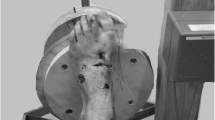Summary
Background: Tears of the lateral ligaments of the ankle may be diagnosed by different methods. Stress radiography is the most widely used technique for routine investigation due to ease of performance and its low cost. However, it often yields false-negative results.
Methods: A prospective comparison in 63 athletically active patients evaluating stress radiography vs. magnetic resonance (MR) imaging in comparison with clinical findings according to different groups of talar tilting was performed; in the 15 patients (24%) the results of the 2 radiological techniques were compared with the intraoperative findings.
Results: Comparing the different groups the correlation actually found was remarkably poor: 32% of all patients had been underdiagnosed, 10% had been overdiagnosed at stress radiography. The sensitivity of MR imaging for the detection of injuries was 93%; specificity was 100%.
Conclusions: Despite 10% false negative findings, MRI gives valuable informations on ankle ligament injury.
Zusammenfassung
Grundlagen: Inversions- oder auch Supinationsverletzungen der lateralen Sprunggelenksbänder können auf vielfältige Art diagnostiziert werden. Die Streßradiographie ist aufgrund ihrer klinischen Praktikabilität und der niedrigen Kosten die am häufigsten angewandte Methode. Allerdings wird damit eine nicht unbeträchtliche Anzahl falsch negativer Resultate erzielt.
Methodik: Verglichen wurden im Rahmen einer prospektiven Studie die Ergebnisse von Streßradiographie und Magnetresonanztomographie an insgesamt 63 sportlich aktiven Patienten, unterteilt in Gruppen unterschiedlicher Schweregrade. Bei 15 Patienten (24%) wurden die beiden Techniken mit den intraoperativen Befunden verglichen.
Ergebnisse: Der Befundvergleich ergab unerwartete Ergebnisse, da die tatsächlich gefundene Korrelation unerwartet niedrig war. 32% der Patienten wurden anhand der Streßradiographie falsch negativ und 10% falsch positiv beurteilt. Die Sensitivität der MRT lag bei 93% im Erkennen operationswürdiger Befunde, die Spezifität bei 100%.
Schlußfolgerungen: Trotz 10% falsch negativer Resultate stellt die MRT eine ausgezeichnete Alternative zur bisherigen Routinediagnostik im Erkennen und Aufzeigen des wahren Ausmaßes ligamentärer Sprunggelenksverletzungen dar.
Similar content being viewed by others
References
Buck RL: It’s only a sprained ankle. Am Fam Pract 1972;6:68–75.
Colville MR: Reconstruction of lateral ankle ligaments.T. J Bone Joint Surg 1994;76A:1092–1102.
Cox JS, Hewes TF: Normal Talar Tilt Angle. Clin Orthop 1979;140:37–41.
Davies M, Fleiss JL: Measuring agreement for multinominal data. Biometrics 1982;38:2047–1051.
Dziob JM: Ligamentous injuries about the ankle joint. Am J Surg 1956;91:692–698.
Ferkel RD, Flannigan BD, Elkins BS: Magnetic Resonance Imaging of the foot and ankle: Correlation of normal anatomy with pathologic conditions. Foot and Ankle 1991;11:289–305.
Kannus P, Renström P: Treatment for acute tears of the lateral ligaments of the ankle. J Bone Joint Surg 1991;73A:305–312.
Karlsson J, Sward L, Andréasson GO: The effect of taping on ankle stability. Practical Implications. Sports Med 1993;16:210–215.
Klein J, Rixen D, Albring Th, Tiling T: Funktionelle versus Gipsbehandlung bei der frischen Außenbandruptur des oberen Sprunggelenks. Eine randomisierte klinische Studie. Unfallchirurg 1991;94:99–104.
Klein J, Schreckenberger C, Röddecker K, Tiling T: Operative oder konservative Behandlung der frischen Außenbandruptur am oberen Sprunggelenk. Randomisierte klinische Studie. Unfallchirurg 1988;91:154–160.
Liou J, Totty WG: Magnetic resonance imaging of ankle injuries. Top Magn Reson Imaging 1991;3:1–22.
Maehlum S, Daljord OA: Acute sports injuries in Oslo — A one year study. Br J Sports Med 1986;18:181–185.
Munk B, Holm-Christensen K, Lind T: Long-term outcome after ruptured lateral ankle ligaments. A prospective study of 3 different treatments in 79 patients with 11-year follow-up. Acta Orthop Scand 1995;66:452–454.
Röder W, Hennes R, Grebe P, Isemer FE: MRT-Monitoring der Wiederherstellung des Bandapparates des oberen Sprunggelenks nach Verletzung. Unfallchirurg 1994;97:457–471.
Rubin G, Witten M: The talar-tilt angle and the fibular collateral ligaments. A method for the determination of talar tilt. J Bone Joint Surgery 1960;42A:311–326.
Twellaar M, Veldhuizen JW, Verstappen FT: Das Knöchelinversionstrauma. Vergleich der Langzeitergebnisse funktioneller Behandlungsmethoden mit Klebeverband und Bandage („Brace“) und die Eignung der Stabilometrie. Unfallchirurg 1993;96:477–482.
Schaap GR, de Keizer G, Marti K: Inversion Trauma on the Ankle. Arch Orthop Trauma Surg 1989;108:273–275.
Schneck CD, Mesgarzadeh M, Bonakdarpour A, Ross GJ: MR Imaging of the most commonly injured ankle ligaments. Part I. Normal Anatomy. Radiology 1992;184:499–505.
Schneck CD, Mesgarzadeh M, Bonakdarpur A: MR Imaging of the most commonly injured ankle ligaments. Part II. Ligament injuries. Radiology 1992;184:507–512.
Smith RW, Reischl SF: Treatment of ankle sprains in young athletes. Am J Sports Med 1986;14:465–471.
Tiling T, Bonk A, Höher J, Klein J: Die akute Außenbandverletzung des Sprunggelenks beim Sportler. Acute ankle sprain in athletes. Chirurg 1994;65:920–933.
Verhagen RAW, de Keizer G, van Dijk CN: Long-term follow-up of inversion trauma of the ankle. Arch Orthop Trauma Surg 1955;114:92–96.
Author information
Authors and Affiliations
Corresponding author
Rights and permissions
About this article
Cite this article
Kukla, C., Gaebler, C., Breitenseher, M. et al. MR imaging vs. stress radiography in diagnosis of ankle inversion trauma. Acta Chir Austriaca 30, 42–45 (1998). https://doi.org/10.1007/BF02619853
Published:
Issue Date:
DOI: https://doi.org/10.1007/BF02619853




